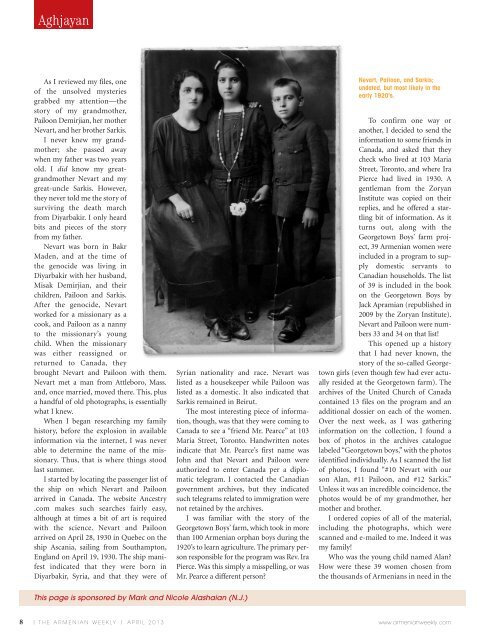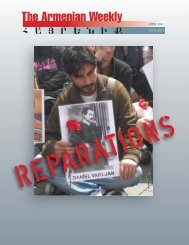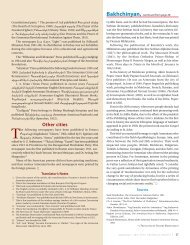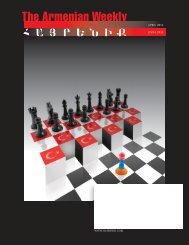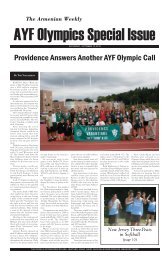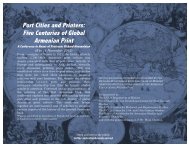Create successful ePaper yourself
Turn your PDF publications into a flip-book with our unique Google optimized e-Paper software.
Aghjayan<br />
As I reviewed my files, one<br />
of the unsolved mysteries<br />
grabbed my attention—the<br />
story of my grandmother,<br />
Pailoon Demirjian, her mother<br />
Nevart, and her brother Sarkis.<br />
I never knew my grandmother;<br />
she passed away<br />
when my father was two years<br />
old. I did know my greatgrandmother<br />
Nevart and my<br />
great-uncle Sarkis. However,<br />
they never told me the story of<br />
surviving the death march<br />
from Diyarbakir. I only heard<br />
bits and pieces of the story<br />
from my father.<br />
Nevart was born in Bakr<br />
Maden, and at the time of<br />
the genocide was living in<br />
Diyarbakir with her husband,<br />
Misak Demirjian, and their<br />
children, Pailoon and Sarkis.<br />
After the genocide, Nevart<br />
worked for a missionary as a<br />
cook, and Pailoon as a nanny<br />
to the missionary’s young<br />
child. When the missionary<br />
was either reassigned or<br />
returned to Canada, they<br />
brought Nevart and Pailoon with them.<br />
Nevart met a man from Attleboro, Mass.<br />
and, once married, moved t<strong>here</strong>. This, plus<br />
a handful of old photographs, is essentially<br />
what I knew.<br />
When I began researching my family<br />
history, before the explosion in available<br />
information via the internet, I was never<br />
able to determine the name of the missionary.<br />
Thus, that is w<strong>here</strong> things stood<br />
last summer.<br />
I started by locating the passenger list of<br />
the ship on which Nevart and Pailoon<br />
arrived in Canada. The website Ancestry<br />
.com makes such searches fairly easy,<br />
although at times a bit of art is required<br />
with the science. Nevart and Pailoon<br />
arrived on April 28, 1930 in Quebec on the<br />
ship Ascania, sailing from Southampton,<br />
England on April 19, 1930. The ship manifest<br />
indicated that they were born in<br />
Diyarbakir, Syria, and that they were of<br />
Syrian nationality and race. Nevart was<br />
listed as a housekeeper while Pailoon was<br />
listed as a domestic. It also indicated that<br />
Sarkis remained in Beirut.<br />
The most interesting piece of information,<br />
though, was that they were coming to<br />
Canada to see a “friend Mr. Pearce” at 103<br />
Maria Street, Toronto. Handwritten notes<br />
indicate that Mr. Pearce’s first name was<br />
John and that Nevart and Pailoon were<br />
authorized to enter Canada per a diplomatic<br />
telegram. I contacted the Canadian<br />
government archives, but they indicated<br />
such telegrams related to immigration were<br />
not retained by the archives.<br />
I was familiar with the story of the<br />
Georgetown Boys’ farm, which took in more<br />
than 100 <strong>Armenian</strong> orphan boys during the<br />
1920’s to learn agriculture. The primary person<br />
responsible for the program was Rev. Ira<br />
Pierce. Was this simply a misspelling, or was<br />
Mr. Pearce a different person?<br />
Nevart, Pailoon, and Sarkis;<br />
undated, but most likely in the<br />
early 1920's.<br />
To confirm one way or<br />
another, I decided to send the<br />
information to some friends in<br />
Canada, and asked that they<br />
check who lived at 103 Maria<br />
Street, Toronto, and w<strong>here</strong> Ira<br />
Pierce had lived in 1930. A<br />
gentleman from the Zoryan<br />
Institute was copied on their<br />
replies, and he offered a startling<br />
bit of information. As it<br />
turns out, along with the<br />
Georgetown Boys’ farm project,<br />
39 <strong>Armenian</strong> women were<br />
included in a program to supply<br />
domestic servants to<br />
Canadian households. The list<br />
of 39 is included in the book<br />
on the Georgetown Boys by<br />
Jack Apramian (republished in<br />
2009 by the Zoryan Institute).<br />
Nevart and Pailoon were numbers<br />
33 and 34 on that list!<br />
This opened up a history<br />
that I had never known, the<br />
story of the so-called George -<br />
town girls (even though few had ever actually<br />
resided at the Georgetown farm). The<br />
archives of the United Church of Canada<br />
contained 13 files on the program and an<br />
additional dossier on each of the women.<br />
Over the next week, as I was gathering<br />
information on the collection, I found a<br />
box of photos in the archives catalogue<br />
labeled “Georgetown boys,” with the photos<br />
identified individually. As I scanned the list<br />
of photos, I found “#10 Nevart with our<br />
son Alan, #11 Pailoon, and #12 Sarkis.”<br />
Unless it was an incredible coincidence, the<br />
photos would be of my grandmother, her<br />
mother and brother.<br />
I ordered copies of all of the material,<br />
including the photographs, which were<br />
scanned and e-mailed to me. Indeed it was<br />
my family!<br />
Who was the young child named Alan?<br />
How were these 39 women chosen from<br />
the thousands of <strong>Armenian</strong>s in need in the<br />
This page is sponsored by Mark and Nicole Alashaian (N.J.)<br />
8<br />
| THE ARMENIAN WEEKLY | APRIL 2013<br />
www.armenianweekly.com


